The Detection of GRBs at VHE: A Challenge Lasting for More than Two Decades, What Is Next?
Abstract
1. Introduction
2. Models for HE and VHE Emission in GRBs
3. Gamma-Ray Bursts Observations at High Energies
- The band model is not able to describe the joint low- and high-energy spectra. An additional component (e.g., extra power law) or a cutoff are needed, with no unique solution for all GRBs. Other GRBs may require an additional thermal blackbody component.
- Fermi-LAT-detected GRBs are among the brightest detected by the Fermi-GBM. The energy released in high-energy gamma-rays (> MeV) in the extended temporal phase is about 10% of the total energy radiated in the prompt phase.
- The high-energy emission is delayed and longer-lasting with respect to the low-energy one. It might extend in time well after the low-energy emission has faded. The temporal decay is generally consistent with a power law behavior with ∼1.
4. GRB Observation at VHE: The Story So Far
- MAGIC (Major Atmospheric Gamma Imaging Cherenkov) is a system of two 17 m IACTs, with a ∼ field of view located on the Canary Island of La Palma. Observations started in 2004 with a single standalone telescope until a second one was added in 2009, improving angular resolution and sensitivity. Extensive follow-up campaigns on GRBs were performed since the beginning of the operations, taking advantage of the instruments low-energy threshold (≲50 GeV) combined with a very fast respositioning speed (∼/s). Despite the continuous improvement in instrument’s reaction to external GRB triggers and in data analysis along the years, no significance evidence of VHE emission was reported during the first ∼15 years of observations. However, remarkable results were achieved in terms of performance, such as the first follow-up of GRBs during the prompt emission phase for a bunch of events such as GRB 050713A (Figure 5, left panel), GRB 131030A, GRB 141026A, and GRB 150428B [4,65,66,67]. Furthermore, within the framework of relativistic shock-wave models, possible emission in the VHE band by synchrotron-self-Compton mechanism in afterglow has been modeled and discussed by the MAGIC collaboration in relation to the obtained upper limits on a few interesting events such as GRB 0804030 [68] and GRB 090102 (Figure 5, right panel), one of the first GRBs with simultaneous data taken with Fermi-LAT [5]. Although not particularly constraining, these results showed that IACT performances were mature enough to play an important role in GRB studies.
- The High-Energy Stereoscopic System (H.E.S.S.) is an array of IACTs operating in Namibia since 2004. The so-called phase-I included four 12 m diameter telescopes, with an energy threshold of ∼100 GeV at zenith, and a field of view. In 2012, a large 28 m diameter telescope was added to the array. This telescope is characterized by a faster repointing and large collection area (∼600 m) that guarantee an energy threshold of 50 GeV. Thus, it is a transient-oriented instrument. The introduction of the new telescope marked the beginning of the H.E.S.S. phase-II operations. Despite these improvements, also for H.E.S.S., the first 15 years of observations did not reveal any significant emission for the observed events. Collection of follow -ups and possible interpretation of the obtained upper limits are summarized in different collaboration works, such as in [69,70,71,72].
- VERITAS (Very Energetic Radiation Imaging Telescope Array System) is an array of four 12 m IACTs located in Arizona operating in the ≳100 GeV band. The system is the successor of Whipple and has activated a GRB observing program since the beginning of the operations in 2007. VERITAS did not report any detectable VHE emission from the sample of the observed GRBs; however, in 2013, VERITAS was the only IACT able to follow up GRB 130427A, the first GRB observed at VHE (see Section 3). Unfortunately, VERITAS was only able to perform observations on GRB 130427A approximately 20 h after the event’s onset. Although at that time Fermi-LAT was still able to detect activity in the HE band, VERITAS did not report a significant emission in the VHE range.The achieved upper limits at ∼100 GeV were able to significantly constrain the proposed emission model, pointing out tensions within the Klein–Nishina and Thomson emission regimes [73] (Figure 6).
4.1. GRB 190114C
4.2. GRB 201216C
4.3. GRB 180720B and GRB 190829A
4.4. GRB 201015A
5. Advances in GRBs Studies and Open Issues at VHE
6. The Next Decades
7. Conclusions
Author Contributions
Funding
Institutional Review Board Statement
Informed Consent Statement
Data Availability Statement
Acknowledgments
Conflicts of Interest
References
- Abdalla, H.; Adam, R.; Aharonian, F.; Ait Benkhali, F.; Angüner, E.O.; Arakawa, M.; Arcaro, C.; Armand, C.; Ashkar, H.; Backes, M.; et al. A very-high-energy component deep in the γ-ray burst afterglow. Nature 2019, 575, 464–467. [Google Scholar] [CrossRef]
- MAGIC Collaboration. Teraelectronvolt emission from the γ-ray burst GRB 190114C. Nature 2019, 575, 455–458. [Google Scholar] [CrossRef]
- H.E.S.S. Collaboration; Abdalla, H.; Aharonian, F.; Ait Benkhali, F.; Angüner, E.O.; Arcaro, C.; Armand, C.; Armstrong, T.; Ashkar, H.; Backes, M.; et al. Revealing X-ray and gamma ray temporal and spectral similarities in the GRB 190829A afterglow. Science 2021, 372, 1081–1085. [Google Scholar] [CrossRef]
- Carosi, A.; Antonelli, A.; Becerra Gonzalez, J.; Berti, A.; Covino, S.; Garczarczyk, M.; Gaug, M.; Lombardi, S.; Longo, F.; Moretti, E.; et al. Recent follow-up observations of GRBs in the very high energy band with the MAGIC Telescopes. In Proceedings of the 34th International Cosmic Ray Conference (ICRC2015), The Hague, The Netherlands, 30 July–6 August 2015; International Cosmic Ray Conference. Volume 34, p. 809. [Google Scholar]
- Aleksić, J.; Ansoldi, S.; Antonelli, L.A.; Antoranz, P.; Babic, A.; Barres de Almeida, U.; Barrio, J.A.; Becerra González, J.; Bednarek, W.; Berger, K.; et al. MAGIC upper limits on the GRB 090102 afterglow. Mon. Not. R. Astron. Soc. 2014, 437, 3103–3111. [Google Scholar] [CrossRef]
- Paczynski, B. Gamma-ray bursters at cosmological distances. Astrophys. J. Lett. 1986, 308, L43–L46. [Google Scholar] [CrossRef]
- Thompson, C. A model of gamma-ray bursts. Mon. Not. R. Astron. Soc. 1994, 270, 480–498. [Google Scholar] [CrossRef]
- Granot, J. Gamma-Ray Bursts from Magnetic Reconnection: Variability and Robustness of Light Curves. Astrophys. J. Lett. 2016, 816, L20. [Google Scholar] [CrossRef]
- Band, D.; Matteson, J.; Ford, L.; Schaefer, B.; Palmer, D.; Teegarden, B.; Cline, T.; Briggs, M.; Paciesas, W.; Pendleton, G.; et al. BATSE Observations of Gamma-Ray Burst Spectra. I. Spectral Diversity. Astrophys. J. 1993, 413, 281. [Google Scholar] [CrossRef]
- Toffano, M.; Ghirlanda, G.; Nava, L.; Ghisellini, G.; Ravasio, M.E.; Oganesyan, G. The slope of the low-energy spectrum of prompt gamma-ray burst emission. Astropart. Astrophys. 2021, 652, A123. [Google Scholar] [CrossRef]
- Basak, R.; Rao, A.R. Discovery of Smoothly Evolving Blackbodies in the Early Afterglow of GRB 090618: Evidence for a Spine-Sheath Jet? Astrophys. J. 2015, 812, 156. [Google Scholar] [CrossRef]
- Cohen, E.; Katz, J.I.; Piran, T.; Sari, R.; Preece, R.D.; Band, D.L. Possible Evidence for Relativistic Shocks in Gamma-Ray Bursts. Astrophys. J. 1997, 488, 330–337. [Google Scholar] [CrossRef]
- Ghirlanda, G.; Celotti, A.; Ghisellini, G. Extremely hard GRB spectra prune down the forest of emission models. Astropart. Astrophys. 2003, 406, 879–892. [Google Scholar] [CrossRef]
- Sari, R.; Esin, A.A. On the Synchrotron Self-Compton Emission from Relativistic Shocks and Its Implications for Gamma-Ray Burst Afterglows. Astrophys. J. 2001, 548, 787–799. [Google Scholar] [CrossRef]
- Zhang, B.; Mészáros, P. High-Energy Spectral Components in Gamma-Ray Burst Afterglows. Astrophys. J. 2001, 559, 110–122. [Google Scholar] [CrossRef]
- Gupta, N.; Zhang, B. Prompt emission of high-energy photons from gamma ray bursts. Mon. Not. R. Astron. Soc. 2007, 380, 78–92. [Google Scholar] [CrossRef]
- Atwood, W.B.; Abdo, A.A.; Ackermann, M.; Althouse, W.; Anderson, B.; Axelsson, M.; Baldini, L.; Ballet, J.; Band, D.L.; Barbiellini, G.; et al. The Large Area Telescope on the Fermi Gamma-Ray Space Telescope Mission. Astrophys. J. 2009, 697, 1071–1102. [Google Scholar] [CrossRef]
- Ghisellini, G.; Ghirlanda, G.; Nava, L.; Celotti, A. GeV emission from gamma-ray bursts: A radiative fireball? Mon. Not. R. Astron. Soc. 2010, 403, 926–937. [Google Scholar] [CrossRef]
- Piran, T. Gamma-ray bursts and the fireball model. Phys. Rep. 1999, 314, 575–667. [Google Scholar] [CrossRef]
- Abdo, A.A.; Ackermann, M.; Arimoto, M.; Asano, K.; Atwood, W.B.; Axelsson, M.; Baldini, L.; Ballet, J.; Band, D.L.; Barbiellini, G.; et al. Fermi Observations of High-Energy Gamma-Ray Emission from GRB 080916C. Science 2009, 323, 1688. [Google Scholar] [CrossRef]
- Ackermann, M.; Asano, K.; Atwood, W.B.; Axelsson, M.; Baldini, L.; Ballet, J.; Barbiellini, G.; Baring, M.G.; Bastieri, D.; Bechtol, K.; et al. Fermi Observations of GRB 090510: A Short-Hard Gamma-ray Burst with an Additional, Hard Power-law Component from 10 keV TO GeV Energies. Astrophys. J. 2010, 716, 1178–1190. [Google Scholar] [CrossRef]
- Blandford, R.D.; McKee, C.F. Fluid dynamics of relativistic blast waves. Phys. Fluids 1976, 19, 1130–1138. [Google Scholar] [CrossRef]
- Guetta, D.; Granot, J. High-Energy Emission from the Prompt Gamma-Ray Burst. Astrophys. J. 2003, 585, 885–889. [Google Scholar] [CrossRef]
- Guetta, D.; Granot, J. Observational implications of a plerionic environment for gamma-ray bursts. Mon. Not. R. Astron. Soc. 2003, 340, 115–138. [Google Scholar] [CrossRef]
- Daigne, F.; Bošnjak, Ž.; Dubus, G. Reconciling observed gamma-ray burst prompt spectra with synchrotron radiation? Astron. Astrophys. 2011, 526, A110. [Google Scholar] [CrossRef]
- Bošnjak, Ž.; Daigne, F.; Dubus, G. Prompt high-energy emission from gamma-ray bursts in the internal shock model. Astron. Astrophys. 2009, 498, 677–703. [Google Scholar] [CrossRef]
- Daigne, F. High-Energy Emission from Gamma-Ray Bursts; International Journal of Modern Physics Conference Series; World Scientific: Singapore, 2012; Volume 8, pp. 196–208. [Google Scholar] [CrossRef]
- Razzaque, S. Modeling and Interpretation of High Energy Emission from GRBs Observed with the Fermi Gamma Ray Space Telescope. In Proceedings of the APS April Meeting Abstracts, Denver, Colorado, 2–5 May 2009; p. W8.003. [Google Scholar]
- Asano, K.; Inoue, S.; Mészáros, P. Prompt High-Energy Emission from Proton-Dominated Gamma-Ray Bursts. Astrophys. J. 2009, 699, 953–957. [Google Scholar] [CrossRef]
- Beniamini, P.; Nava, L.; Duran, R.B.; Piran, T. Energies of GRB blast waves and prompt efficiencies as implied by modelling of X-ray and GeV afterglows. Mon. Not. R. Astron. Soc. 2015, 454, 1073–1085. [Google Scholar] [CrossRef]
- Wang, X.Y.; He, H.N.; Li, Z.; Wu, X.F.; Dai, Z.G. Klein-Nishina Effects on the High-energy Afterglow Emission of Gamma-ray Bursts. Astrophys. J. 2010, 712, 1232–1240. [Google Scholar] [CrossRef]
- Liu, R.Y.; Wang, X.Y.; Wu, X.F. Interpretation of the Unprecedentedly Long-lived High-energy Emission of GRB 130427A. Astrophys. J. Lett. 2013, 773, L20. [Google Scholar] [CrossRef]
- Wang, X.Y.; Dai, Z.G.; Lu, T. Prompt High-Energy Gamma-Ray Emission from the Synchrotron Self-Compton Process in the Reverse Shocks of Gamma-Ray Bursts. Astrophys. J. Lett. 2001, 546, L33–L37. [Google Scholar] [CrossRef]
- Granot, J.; Guetta, D. Explaining the High-Energy Spectral Component in GRB 941017. Astrophys. J. Lett. 2003, 598, L11–L14. [Google Scholar] [CrossRef]
- Böttcher, M.; Dermer, C.D. High-energy Gamma Rays from Ultra-high-energy Cosmic-Ray Protons in Gamma-Ray Bursts. Astrophys. J. Lett. 1998, 499, L131–L134. [Google Scholar] [CrossRef]
- Nava, L. High-energy emission from gamma-ray bursts. Int. J. Mod. Phys. D 2018, 27, 1842003. [Google Scholar] [CrossRef]
- Hurley, K.; Dingus, B.L.; Mukherjee, R.; Sreekumar, P.; Kouveliotou, C.; Meegan, C.; Fishman, G.J.; Band, D.; Ford, L.; Bertsch, D.; et al. Detection of a γ-ray burst of very long duration and very high energy. Nature 1994, 372, 652–654. [Google Scholar] [CrossRef]
- Merck, M.; Bertsch, D.L.; Dingus, B.L.; Fichtel, C.E.; Hartman, R.C.; Hunter, S.D.; Kanbach, G.; Kniffen, D.A.; Lin, Y.C.; Mayer-Hasselzuander, H.A.; et al. Observations of High-Energy Gamma-ray Bursts with EGRET. In IAU Colloq. 151: Flares and Flashes; Springer: Berlin/Heidelberg, Germany, 1995; Volume 454, p. 358. [Google Scholar] [CrossRef]
- González, M.M.; Dingus, B.L.; Kaneko, Y.; Preece, R.D.; Dermer, C.D.; Briggs, M.S. A γ-ray burst with a high-energy spectral component inconsistent with the synchrotron shock model. Nature 2003, 424, 749–751. [Google Scholar] [CrossRef]
- Tavani, M.; Barbiellini, G.; Argan, A.; Boffelli, F.; Bulgarelli, A.; Caraveo, P.; Cattaneo, P.W.; Chen, A.W.; Cocco, V.; Costa, E.; et al. The AGILE Mission. Astron. Astrophys. 2009, 502, 995–1013. [Google Scholar] [CrossRef]
- Giuliani, A.; Mereghetti, S.; Fornari, F.; Del Monte, E.; Feroci, M.; Marisaldi, M.; Esposito, P.; Perotti, F.; Tavani, M.; Argan, A.; et al. AGILE detection of delayed gamma-ray emission from GRB 080514B. Astron. Astrophys. 2008, 491, L25–L28. [Google Scholar] [CrossRef][Green Version]
- Del Monte, E.; Barbiellini, G.; Donnarumma, I.; Fuschino, F.; Giuliani, A.; Longo, F.; Marisaldi, M.; Pucella, G.; Tavani, M.; Trifoglio, M.; et al. The AGILE observations of the hard and bright GRB 100724B. Astron. Astrophys. 2011, 535, A120. [Google Scholar] [CrossRef]
- Longo, F.; Moretti, E.; Nava, L.; Desiante, R.; Olivo, M.; Del Monte, E.; Rappoldi, A.; Fuschino, F.; Marisaldi, M.; Giuliani, A.; et al. Upper limits on the high-energy emission from gamma-ray bursts observed by AGILE-GRID. Astron. Astrophys. 2012, 547, A95. [Google Scholar] [CrossRef]
- Meegan, C.; Lichti, G.; Bhat, P.N.; Bissaldi, E.; Briggs, M.S.; Connaughton, V.; Diehl, R.; Fishman, G.; Greiner, J.; Hoover, A.S.; et al. The Fermi Gamma-ray Burst Monitor. Astrophys. J. 2009, 702, 791–804. [Google Scholar] [CrossRef]
- Abdo, A.A.; Ackermann, M.; Asano, K.; Atwood, W.B.; Axelsson, M.; Baldini, L.; Ballet, J.; Band, D.L.; Barbiellini, G.; Bastieri, D.; et al. Fermi Observations of High-energy Gamma-ray Emission from GRB 080825C. Astrophys. J. 2009, 707, 580–592. [Google Scholar] [CrossRef][Green Version]
- Abdo, A.A.; Ackermann, M.; Ajello, M.; Asano, K.; Atwood, W.B.; Axelsson, M.; Baldini, L.; Ballet, J.; Barbiellini, G.; Bastieri, D.; et al. Fermi Detection of Delayed GeV Emission from the Short Gamma-Ray Burst 081024B. Astrophys. J. 2010, 712, 558–564. [Google Scholar] [CrossRef]
- Giuliani, A.; Fuschino, F.; Vianello, G.; Marisaldi, M.; Mereghetti, S.; Tavani, M.; Cutini, S.; Barbiellini, G.; Longo, F.; Moretti, E.; et al. AGILE Detection of Delayed Gamma-ray Emission From the Short Gamma-Ray Burst GRB 090510. Astrophys. J. 2010, 708, L84–L88. [Google Scholar] [CrossRef]
- Fan, Y.Z.; Piran, T.; Narayan, R.; Wei, D.M. High-energy afterglow emission from gamma-ray bursts. Mon. Not. R. Astron. Soc. 2008, 384, 1483–1501. [Google Scholar] [CrossRef]
- Asano, K.; Guiriec, S.; Mészáros, P. Hadronic Models for the Extra Spectral Component in the Short GRB 090510. Astrophys. J. Lett. 2009, 705, L191–L194. [Google Scholar] [CrossRef]
- Ackermann, M.; Ajello, M.; Asano, K.; Atwood, W.B.; Axelsson, M.; Baldini, L.; Ballet, J.; Barbiellini, G.; Baring, M.G.; Bastieri, D.; et al. Fermi-LAT Observations of the Gamma-Ray Burst GRB 130427A. Science 2014, 343, 42–47. [Google Scholar] [CrossRef]
- Kouveliotou, C.; Granot, J.; Racusin, J.L.; Bellm, E.; Vianello, G.; Oates, S.; Fryer, C.L.; Boggs, S.E.; Christensen, F.E.; Craig, W.W.; et al. NuSTAR Observations of GRB 130427A Establish a Single Component Synchrotron Afterglow Origin for the Late Optical to Multi-GeV Emission. Astrophys. J. Lett. 2013, 779, L1. [Google Scholar] [CrossRef]
- Ackermann, M.; Ajello, M.; Asano, K.; Axelsson, M.; Baldini, L.; Ballet, J.; Barbiellini, G.; Bastieri, D.; Bechtol, K.; Bellazzini, R.; et al. The First Fermi-LAT Gamma-Ray Burst Catalog. Astrophys. J. Suppl. 2013, 209, 11. [Google Scholar] [CrossRef]
- Weekes, T.C.; Cawley, M.F.; Fegan, D.J.; Gibbs, K.G.; Hillas, A.M.; Kowk, P.W.; Lamb, R.C.; Lewis, D.A.; Macomb, D.; Porter, N.A.; et al. Observation of TeV Gamma Rays from the Crab Nebula Using the Atmospheric Cerenkov Imaging Technique. Astrophys. J. 1989, 342, 379. [Google Scholar] [CrossRef]
- Boella, G.; Butler, R.C.; Perola, G.C.; Piro, L.; Scarsi, L.; Bleeker, J.A.M. BeppoSAX, the wide band mission for X-ray astronomy. Astron. Astrophys. Suppl. 1997, 122, 299–307. [Google Scholar] [CrossRef]
- Hurley, K.; Sommer, M.; Boer, M.; Niel, M.; Laros, J.; Fenimore, E.; Klebesadel, R.; Fishman, G.; Kouveliotou, C.; Meegan, C.; et al. ULYSSES precise localizations of gamma-ray bursts. Astropart. Astrophys. 1993, 97, 39–41. [Google Scholar]
- Alexandreas, D.E.; Allen, G.E.; Berley, D.; Biller, S.; Burman, R.L.; Cavalli-Sforza, M.; Chang, C.Y.; Chen, M.L.; Chumney, P.; Coyne, D.; et al. Search for Ultra High Energy Radiation from Gamma-Ray Bursts; Gamma-Ray, B., Fishman, G.J., Eds.; American Institute of Physics Conference Series; American Institute of Physics: College Park, MD, USA, 1994; Volume 307, pp. 481–485. [Google Scholar]
- Padilla, L.; Funk, B.; Krawczynski, H.; Contreras, J.L.; Moralejo, A.; Aharonian, F.; Akhperjanian, A.G.; Barrio, J.A.; Beteta, J.G.; Cortina, J.; et al. Search for gamma-ray bursts above 20 TeV with the HEGRA AIROBICC Cherenkov array. Astron. Astrophys. 1998, 337, 43–50. [Google Scholar]
- Catanese, M.; Chantell, M.; Covault, C.E.; Cronin, J.W.; Fick, B.E.; Fortson, L.F.; Fowler, J.W.; Gibbs, K.G.; Glasmacher, M.A.K.; Green, K.D.; et al. Search for Ultra High Energy (UHE) γ-ray counterparts of BATSE 3B catalog events. In Gamma-ray Bursts: 3rd Huntsville Symposium; Kouveliotou, C., Briggs, M.F., Fishman, G.J., Eds.; American Institute of Physics Conference Series; American Institute of Physics: College Park, MD, USA, 1996; Volume 384, pp. 598–602. [Google Scholar] [CrossRef]
- Aglietta, M.; Alessandro, B.; Antonioli, P.; Arneodo, F.; Bergamasco, L.; Bertaina, M.; Castagnoli, C.; Castellina, A.; Chiavassa, A.; Cini, G.; et al. Search for high energy GRBs with EASTOP. Astron. Astrophys. 1999, 138, 595–596. [Google Scholar] [CrossRef][Green Version]
- Atkins, R.; Benbow, W.; Berley, D.; Chen, M.L.; Coyne, D.G.; Delay, R.S.; Dingus, B.L.; Dorfan, D.E.; Ellsworth, R.W.; Espinoza, C.; et al. Milagrito, a TeV air-shower array. Nucl. Instrum. Methods Phys. Res. A 2000, 449, 478–499. [Google Scholar] [CrossRef]
- Atkins, R.; Benbow, W.; Berley, D.; Chen, M.L.; Coyne, D.G.; Dingus, B.L.; Dorfan, D.E.; Ellsworth, R.W.; Evans, D.; Falcone, A.; et al. The High-Energy Gamma-Ray Fluence and Energy Spectrum of GRB 970417a from Observations with Milagrito. Astrophys. J. 2003, 583, 824–832. [Google Scholar] [CrossRef]
- Connaughton, V.; Ackerlof, C.W.; Barthelmy, S.; Biller, S.; Boyle, P.; Buckley, J.; Carter-Lewis, D.A.; Cantanese, M.; Cawley, M.F.; Cline, T.; et al. A Search for TeV Counterparts to BATSE Gamma-Ray Bursts. Astrophys. J. 1997, 479, 859–867. [Google Scholar] [CrossRef]
- Gehrels, N.; Chincarini, G.; Giommi, P.; Mason, K.O.; Nousek, J.A.; Wells, A.A.; White, N.E.; Barthelmy, S.D.; Burrows, D.N.; Cominsky, L.R.; et al. The Swift Gamma-Ray Burst Mission. Astrophys. J. 2004, 611, 1005–1020. [Google Scholar] [CrossRef]
- Gehrels, N.; Razzaque, S. Gamma-ray bursts in the swift-Fermi era. Front. Phys. 2013, 8, 661–678. [Google Scholar] [CrossRef]
- Albert, J.; Aliu, E.; Anderhub, H.; Antoranz, P.; Armada, A.; Baixeras, C.; Barrio, J.A.; Bartko, H.; Bastieri, D.; Becker, J.; et al. MAGIC Upper Limits on the Very High Energy Emission from Gamma-Ray Bursts. Astrophys. J. 2007, 667, 358–366. [Google Scholar] [CrossRef]
- Albert, J.; Aliu, E.; Anderhub, H.; Antoranz, P.; Armada, A.; Asensio, M.; Baixeras, C.; Barrio, J.A.; Bartelt, M.; Bartko, H.; et al. Flux Upper Limit on Gamma-Ray Emission by GRB 050713a from MAGIC Telescope Observations. Astrophys. J. Lett. 2006, 641, L9–L12. [Google Scholar] [CrossRef]
- Berti, A.; Antonelli, L.A.; Bosnjak, Z.; Cortina, J.; Covino, S.; D’Elia, V.; Espiñeira, E.d.S.; Fukami, S.; Inoue, S.; Longo, F.; et al. Searching for GRBs at VHE with MAGIC: The status before CTA. In Proceedings of the 36th International Cosmic Ray Conference (ICRC2019), International Cosmic Ray Conference. Madison, WI, USA, 25 July–1 August 2019; Volume 36, p. 634. [Google Scholar]
- Aleksić, J.; Anderhub, H.; Antonelli, L.A.; Antoranz, P.; Backes, M.; Baixeras, C.; Balestra, S.; Barrio, J.A.; Bastieri, D.; Becerra González, J.; et al. MAGIC observation of the GRB 080430 afterglow. Astron. Astrophys. 2010, 517, A5. [Google Scholar] [CrossRef]
- Aharonian, F.; Akhperjanian, A.G.; Barres de Almeida, U.; Bazer-Bachi, A.R.; Behera, B.; Benbow, W.; Bernlöhr, K.; Boisson, C.; Bochow, A.; Borrel, V.; et al. HESS observations of γ-ray bursts in 2003–2007. Astron. Astrophys. 2009, 495, 505–512. [Google Scholar] [CrossRef]
- Aharonian, F.; Akhperjanian, A.G.; Barres DeAlmeida, U.; Bazer-Bachi, A.R.; Behera, B.; Beilicke, M.; Benbow, W.; Bernlöhr, K.; Boisson, C.; Borrel, V.; et al. HESS Observations of the Prompt and Afterglow Phases of GRB 060602B. Astrophys. J. 2009, 690, 1068–1073. [Google Scholar] [CrossRef]
- H.E.S.S. Collaboration; Abramowski, A.; Aharonian, F.; Ait Benkhali, F.; Akhperjanian, A.G.; Angüner, E.; Anton, G.; Balenderan, S.; Balzer, A.; Barnacka, A.; et al. Search for TeV Gamma-ray Emission from GRB 100621A, an extremely bright GRB in X-rays, with H.E.S.S. Astron. Astrophys. 2014, 565, A16. [Google Scholar] [CrossRef]
- Hoischen, C.; Balzer, A.; Bissaldi, E.; Füßling, M.; Garrigoux, T.; Gottschall, D.; Holler, M.; Mitchell, A.; O’Brien, P.; Parsons, R.; et al. GRB Observations with H.E.S.S. II. In Proceedings of the 35th International Cosmic Ray Conference (ICRC2017), Busan, Korea, 12–20 July 2017; International Cosmic Ray Conference. Volume 301, p. 636. [Google Scholar]
- Aliu, E.; Aune, T.; Barnacka, A.; Beilicke, M.; Benbow, W.; Berger, K.; Biteau, J.; Buckley, J.H.; Bugaev, V.; Byrum, K.; et al. Constraints on Very High Energy Emission from GRB 130427A. Astrophys. J. Lett. 2014, 795, L3. [Google Scholar] [CrossRef]
- Bartoli, B.; Bernardini, P.; Bi, X.J.; Branchini, P.; Budano, A.; Camarri, P.; Cao, Z.; Cardarelli, R.; Catalanotti, S.; Chen, S.Z.; et al. Search for GeV Gamma-Ray Bursts with the ARGO-YBJ Detector: Summary of Eight Years of Observations. Astrophys. J. 2014, 794, 82. [Google Scholar] [CrossRef][Green Version]
- Blanch, O.; Gaug, M.; Noda, K.; Berti, A.; Moretti, E.; Miceli, D.; Gliwny, P.; Ubach, S.; Schleicher, B.; Cerruti, M.; et al. MAGIC observations of GRB 201015A: Hint of very high energy gamma-ray signal. GRB Coord. Netw. 2020, 28659, 1. [Google Scholar]
- MAGIC Collaboration. Observation of inverse Compton emission from a long γ-ray burst. Nature 2019, 575, 459–463. [Google Scholar] [CrossRef]
- Blanch, O.; Longo, F.; Berti, A.; Fukami, S.; Suda, Y.; Loporchio, S.; Micanovic, S.; Green, J.G.; Pinter, V.; Takahashi, M.; et al. GRB 201216C: MAGIC detection in very high energy gamma rays. GRB Coord. Netw. 2020, 29075, 1. [Google Scholar]
- Beardmore, A.P.; Gropp, J.D.; Kennea, J.A.; Klingler, N.J.; Laha, S.; Lien, A.Y.; Moss, M.J.; Page, K.L.; Palmer, D.M.; Tohuvavohu, A.; et al. GRB 201216C: Swift detection of a burst. GRB Coord. Netw. 2020, 29061, 1. [Google Scholar]
- Vielfaure, J.B.; Izzo, L.; Xu, D.; Vergani, S.D.; Malesani, D.B.; de Ugarte Postigo, A.; D’Elia, V.; Fynbo, J.P.U.; Kann, D.A.; Levan, A.J.; et al. GRB 201216C: VLT X-shooter spectroscopy and potential high redshift of a VHE-emitting GRB. GRB Coord. Netw. 2020, 29077, 1. [Google Scholar]
- Fukami, S.; Berti, A.; Loporchio, S.; Suda, Y.; Nava, L.; Noda, K.; Bošnjak, V.; Asano, K.; Longo, F.; Acciari, V.A.; et al. Very-high-energy gamma-ray emission from GRB 201216C detected by MAGIC. PoS 2021, ICRC2021, 788. [Google Scholar] [CrossRef]
- Fermi GBM Team. GRB 190829A: Fermi GBM Final Real-time Localization. GRB Coord. Netw. 2019, 25551, 1. [Google Scholar]
- Dichiara, S.; Bernardini, M.G.; Burrows, D.N.; D’Avanzo, P.; Gronwall, C.; Gropp, J.D.; Kennea, J.A.; Klingler, N.J.; Krimm, H.A.; Kuin, N.P.M.; et al. GRB 190829A: Swift detection of a burst consistent with a galaxy at z=0.08. GRB Coord. Netw. 2019, 25552, 1. [Google Scholar]
- Hu, Y.D.; Castro-Tirado, A.J.; Kumar, A.; Gupta, R.; Valeev, A.F.; Pandey, S.B.; Kann, D.A.; Castellón, A.; Agudo, I.; Aryan, A.; et al. 10.4 m GTC observations of the nearby VHE-detected GRB 190829A/SN 2019oyw. Astron. Astrophys. 2021, 646, A50. [Google Scholar] [CrossRef]
- Zhang, B.T.; Murase, K.; Veres, P.; Mészáros, P. External Inverse-Compton Emission from Low-luminosity Gamma-Ray Bursts: Application to GRB 190829A. Astrophys. J. 2021, 920, 55. [Google Scholar] [CrossRef]
- Zhang, L.L.; Ren, J.; Huang, X.L.; Liang, Y.F.; Lin, D.B.; Liang, E.W. Nearby SN-associated GRB 190829A: Environment, Jet Structure, and VHE Gamma-Ray Afterglows. Astrophys. J. 2021, 917, 95. [Google Scholar] [CrossRef]
- Salafia, O.S.; Ravasio, M.E.; Yang, J.; An, T.; Orienti, M.; Ghirlanda, G.; Nava, L.; Giroletti, M.; Mohan, P.; Spinelli, R.; et al. Multi-wavelength view of the close-by GRB~190829A sheds light on gamma-ray burst physics. arXiv 2021, arXiv:2106.07169. [Google Scholar]
- Roberts, O.J.; Meegan, C. GRB 180720B: Fermi GBM observation. GRB Coord. Netw. 2018, 22981, 1. [Google Scholar]
- Evans, P.A.; Breeveld, A.A.; Deich, A.; Gropp, J.D.; Kennea, J.A.; Krimm, H.A.; Lien, A.Y.; Marshall, F.E.; Page, K.L.; Siegel, M.H.; et al. GRB 180620B: Swift detection of a burst with an optical counterpart. GRB Coord. Netw. 2018, 22807, 1. [Google Scholar]
- Bissaldi, E.; Racusin, J.L. GRB 180720B: Fermi-LAT detection. GRB Coord. Netw. 2018, 22980, 1. [Google Scholar]
- Suda, Y.; Artero, M.; Asano, K.; Berti, A.; Nava, L.; Noda, K.; Terauchi, K.; Acciari, V.A.; Ansoldi, S.; Antonelli, L.A.; et al. Observation of a relatively low luminosity long duration GRB 201015A by the MAGIC telescopes. PoS 2021, ICRC2021, 797. [Google Scholar] [CrossRef]
- Ghirlanda, G.; Nappo, F.; Ghisellini, G.; Melandri, A.; Marcarini, G.; Nava, L.; Salafia, O.S.; Campana, S.; Salvaterra, R. Bulk Lorentz factors of gamma-ray bursts. Astron. Astrophys. 2018, 609, A112. [Google Scholar] [CrossRef]
- Zhang, S.; Shao, L.; Zhang, B.B.; Zou, J.H.; Sun, H.Y.; Yao, Y.j.; Li, L.l. A Tight Three-parameter Correlation and Related Classification on Gamma-Ray Bursts. Astrophys. J. 2022, 926, 170. [Google Scholar] [CrossRef]
- Li, Y.; Zhang, B.; Lü, H.J. A COMPARATIVE STUDY OF LONG AND SHORT GRBS. I. OVERLAPPING PROPERTIES. Astrophys. J. Suppl. Ser. 2016, 227, 7. [Google Scholar] [CrossRef]
- Wood, J. Results from the first one and a half years of the HAWC GRB program. arXiv 2018, arXiv:1801.01437. [Google Scholar]
- Carosi, A.; Ashkar, H.; Berti, A.; Bordas, P.; de Bony Lavergne, M.; Donini, A.; Dalchenko, M.; Fiasson, A.; Foffano, L.; Fukami, S.; et al. First follow-up of transient events with the CTA Large Size Telescope prototype. In Proceedings of the 37th International Cosmic Ray Conference, Berlin, Germany, 12–23 July 2021. [Google Scholar]
- Acciari, V.A.; Ansoldi, S.; Antonelli, L.A.; Arbet Engels, A.; Asano, K.; Baack, D.; Babić, A.; Baquero, A.; Barres de Almeida, U.; Barrio, J.A.; et al. MAGIC Observations of the Nearby Short Gamma-Ray Burst GRB 160821B. Astrophys. J. 2021, 908, 90. [Google Scholar] [CrossRef]
- Acciari, V.A.; Ansoldi, S.; Antonelli, L.A.; Arbet Engels, A.; Baack, D.; Babić, A.; Banerjee, B.; Barres de Almeida, U.; Barrio, J.A.; Becerra González, J.; et al. Bounds on Lorentz Invariance Violation from MAGIC Observation of GRB 190114C. Phys. Rev. Lett. 2020, 125, 021301. [Google Scholar] [CrossRef]
- Abdalla, H.; Abe, H.; Acero, F.; Acharyya, A.; Adam, R.; Agudo, I.; Aguirre-Santaella, A.; Alfaro, R.; Alfaro, J.; Alispach, C.; et al. Sensitivity of the Cherenkov Telescope Array for probing cosmology and fundamental physics with gamma-ray propagation. J. Cosmol. Astropart. Phys. 2021, 2021, 048. [Google Scholar] [CrossRef]
- Carosi, A.; López-Oramas, A.; Longo, F. The Cherenkov Telescope Array transient and multi-messenger program. In Proceedings of the 37th International Cosmic Ray Conference, Berlin, Germany, 12–23 July 2021. [Google Scholar]
- Inoue, S.; Granot, J.; O’Brien, P.T.; Asano, K.; Bouvier, A.; Carosi, A.; Connaughton, V.; Garczarczyk, M.; Gilmore, R.; Hinton, J.; et al. Gamma-ray burst science in the era of the Cherenkov Telescope Array. Astropart. Phys. 2013, 43, 252–275. [Google Scholar] [CrossRef]
- Bernardini, M.G.; Bissaldi, E.; Bosnjak, Z.; Carosi, A.; D’Avanzo, P.; Di Girolamo, T.; Inoue, S.; Gasparetto, T.; Ghirlanda, F.; Longo, F.; et al. POSyTIVE-a GRB population study for the Cherenkov Telescope Array. In Proceedings of the 36th International Cosmic Ray Conference (ICRC2019), Madison, WI, USA, 24 July–1 August 2019; International Cosmic Ray Conference. Volume 36, p. 598. [Google Scholar]
- Amati, L.; Frontera, F.; Tavani, M.; in’t Zand, J.J.M.; Antonelli, A.; Costa, E.; Feroci, M.; Guidorzi, C.; Heise, J.; Masetti, N.; et al. Intrinsic spectra and energetics of BeppoSAX Gamma-Ray Bursts with known redshifts. Astron. Astrophys. 2002, 390, 81–89. [Google Scholar] [CrossRef]
- Cortina, J.; Project, C.L. Status of the Large Size Telescopes of the Cherenkov Telescope Array. In Proceedings of the 36th International Cosmic Ray Conference (ICRC2019), Madison, WI, USA, 24 July–1 August 2019; International Cosmic Ray Conference. Volume 36, p. 653. [Google Scholar]
- Scuderi, S. The ASTRI Mini-Array at the Teide Observatory; Society of Photo-Optical Instrumentation Engineers (SPIE) Conference Series; Society of Photo-Optical Instrumentation Engineers: Bellingham, WA, USA, 2021; Volume 11822, p. 1182202. [Google Scholar] [CrossRef]
- Stamerra, A.; Saturni, F.G.; Green, J.; Nava, L.; Lucarelli, F.; Antonelli, L. TeV Transients with the ASTRI Mini-Array: A case study with GRB 190114C. In Proceedings of the 37th International Cosmic Ray Conference (ICRC2021), Berlin, Germany, 12–23 July 2021; International Cosmic Ray Conference. Volume 395, p. 890. [Google Scholar]
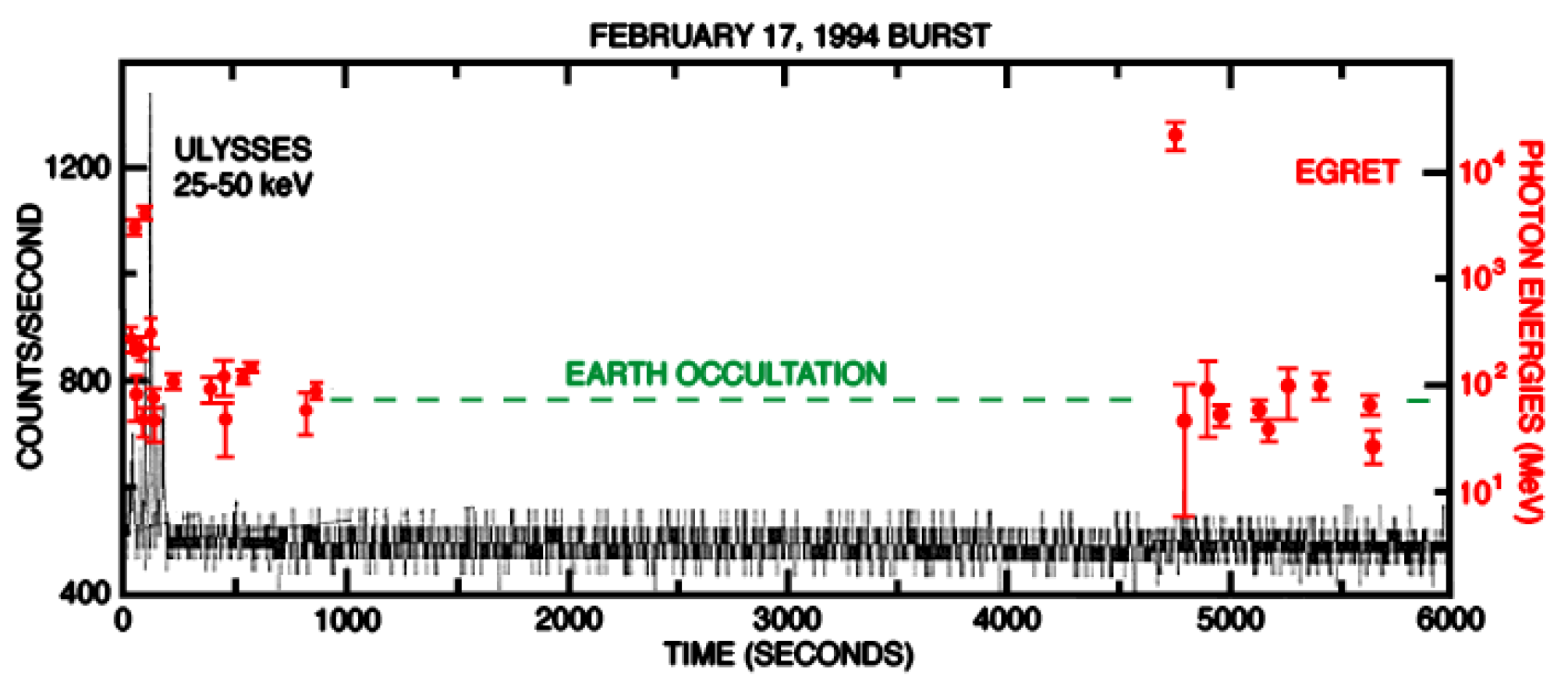
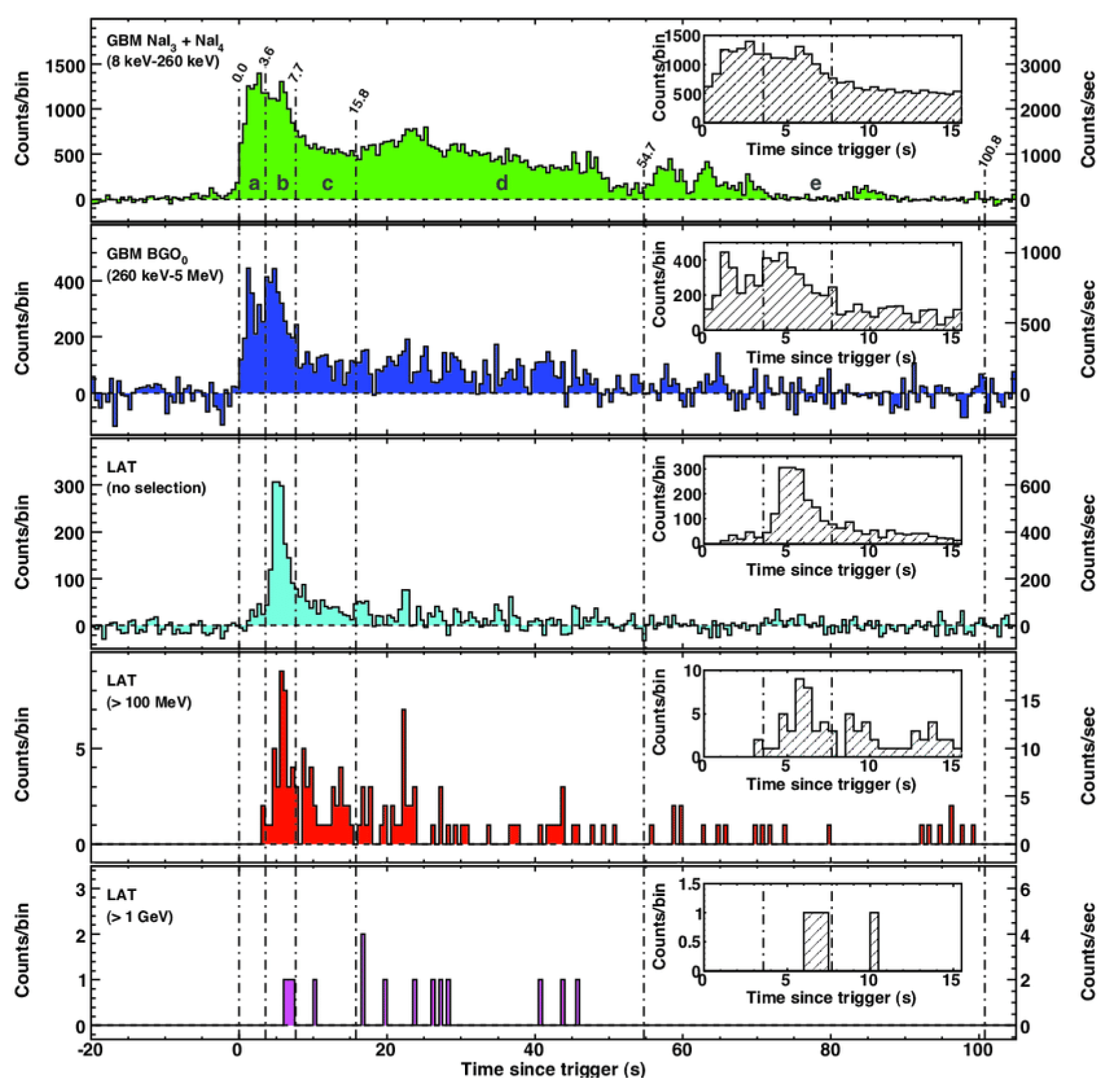
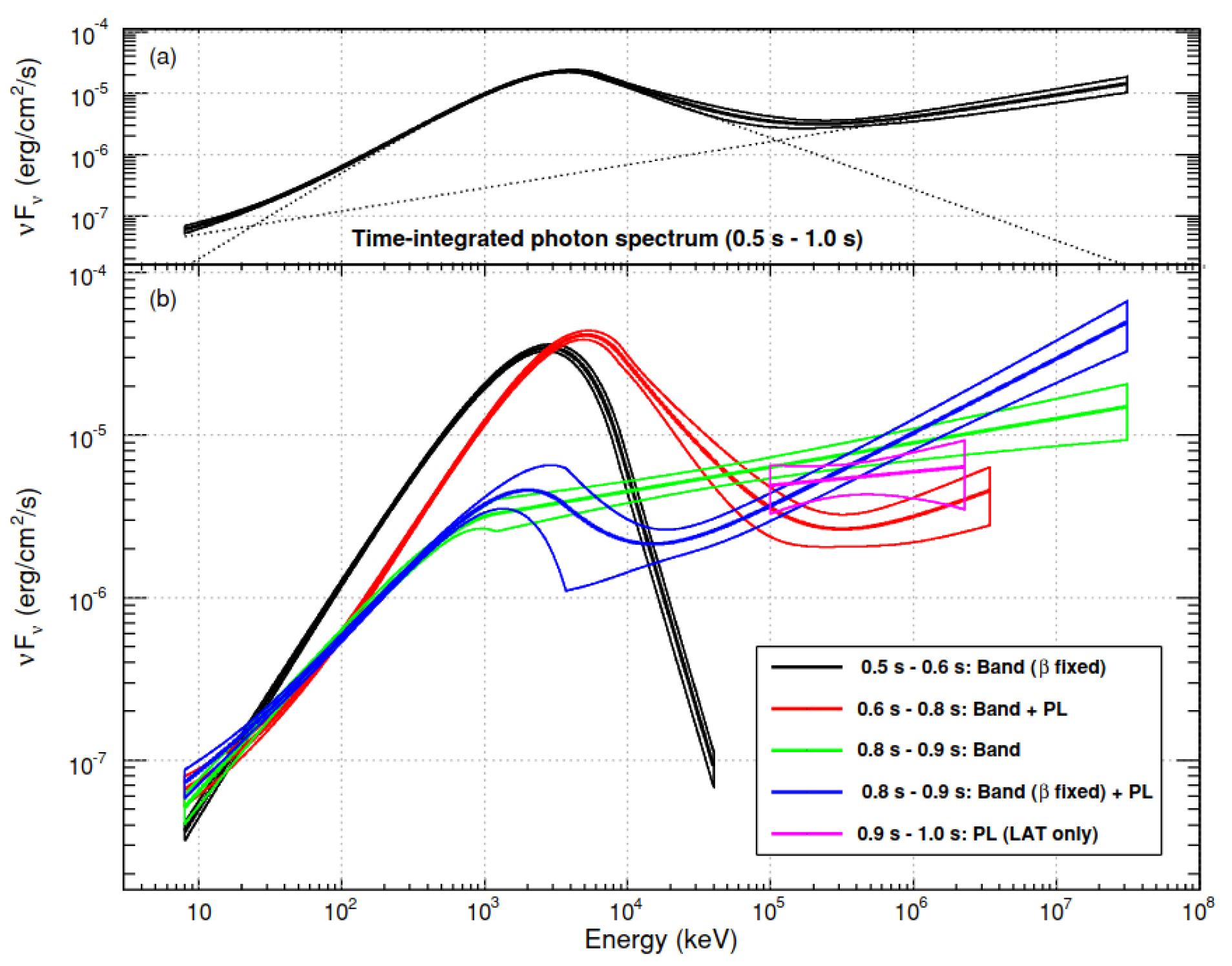
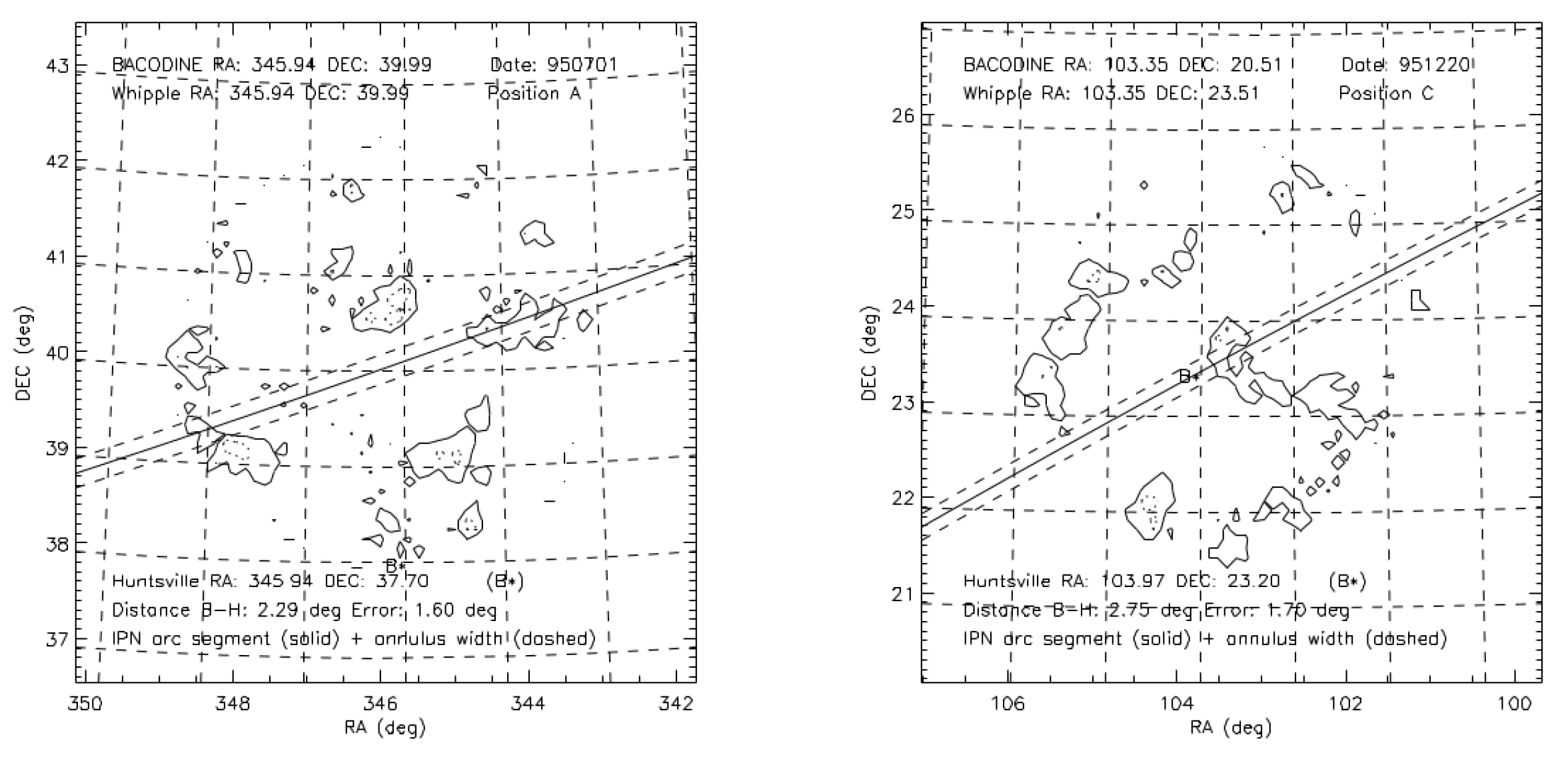


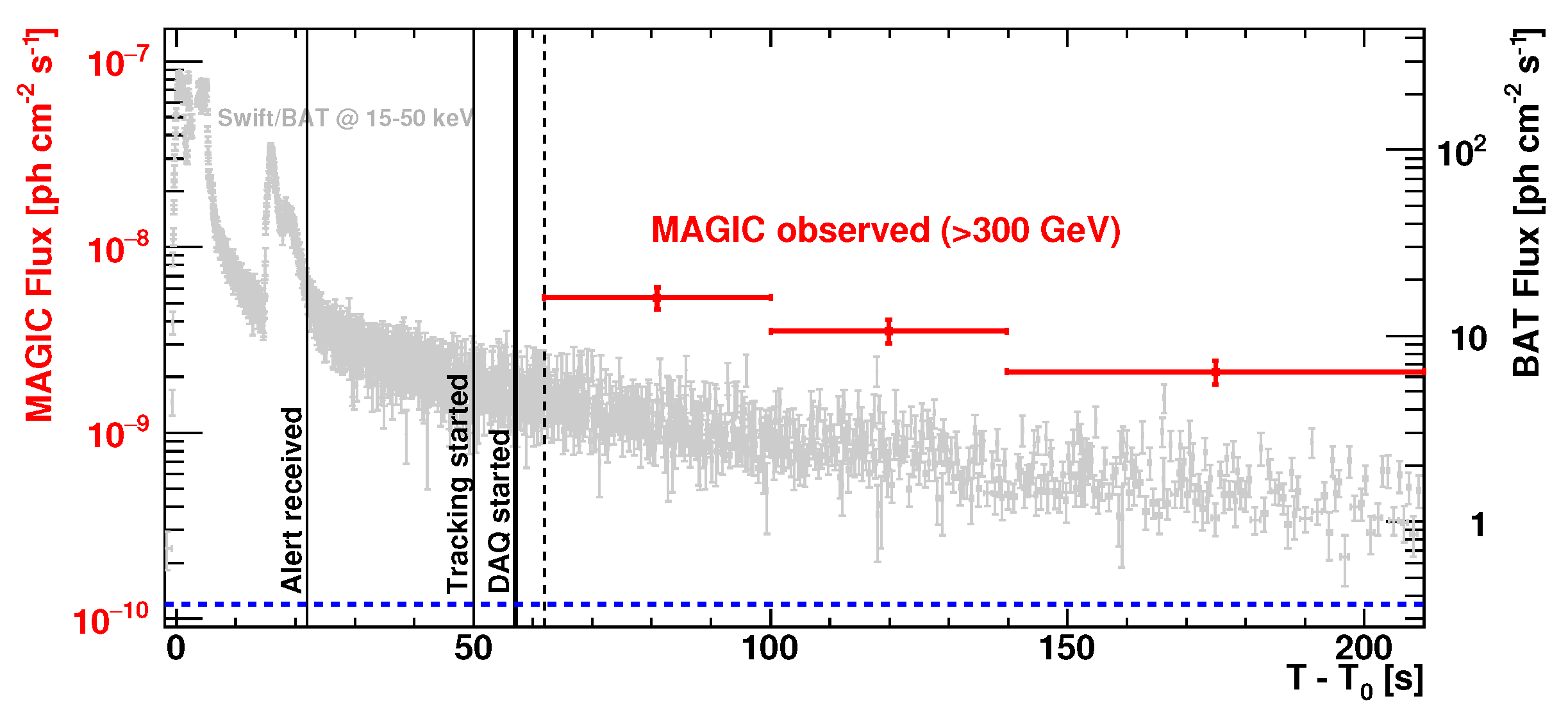
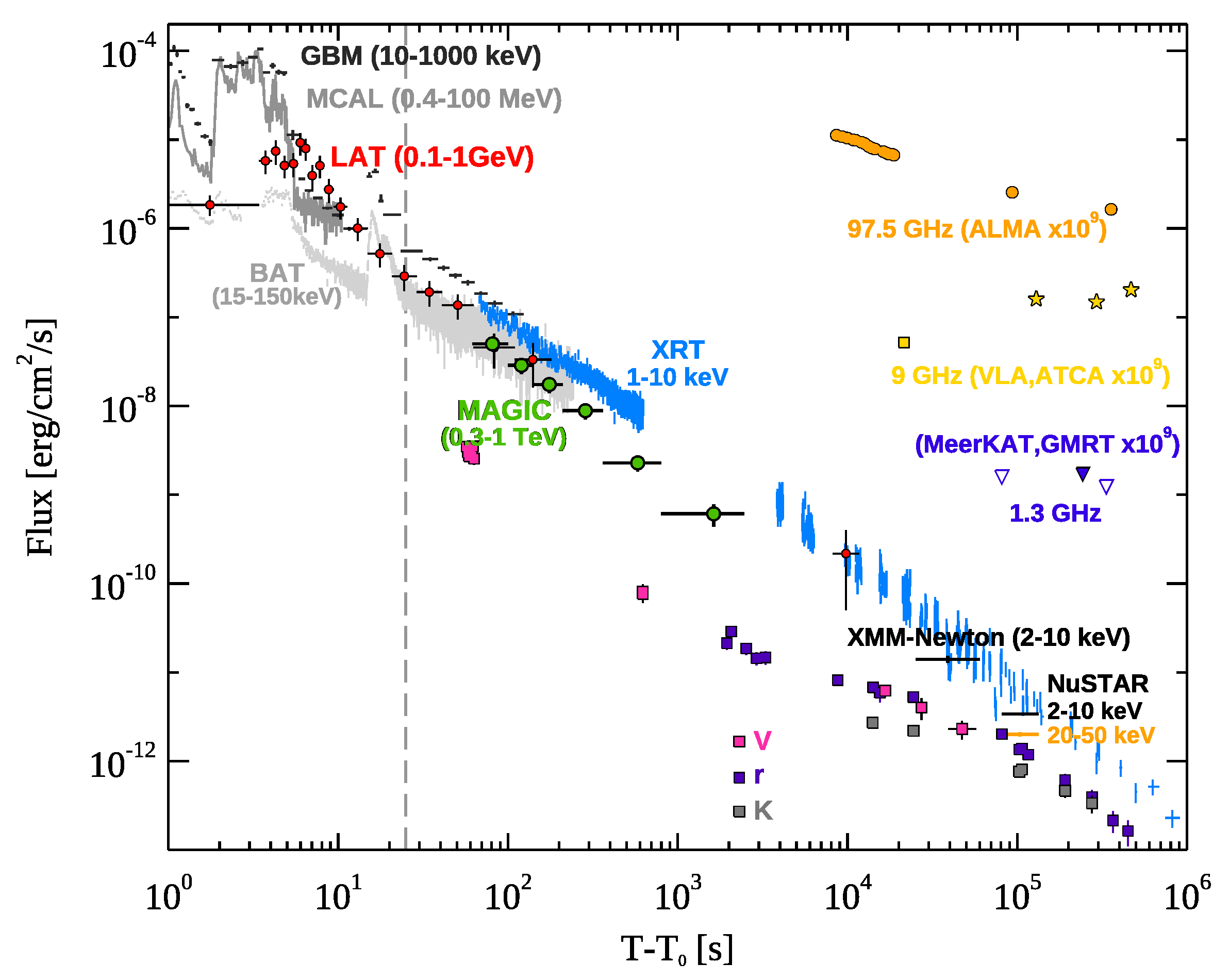
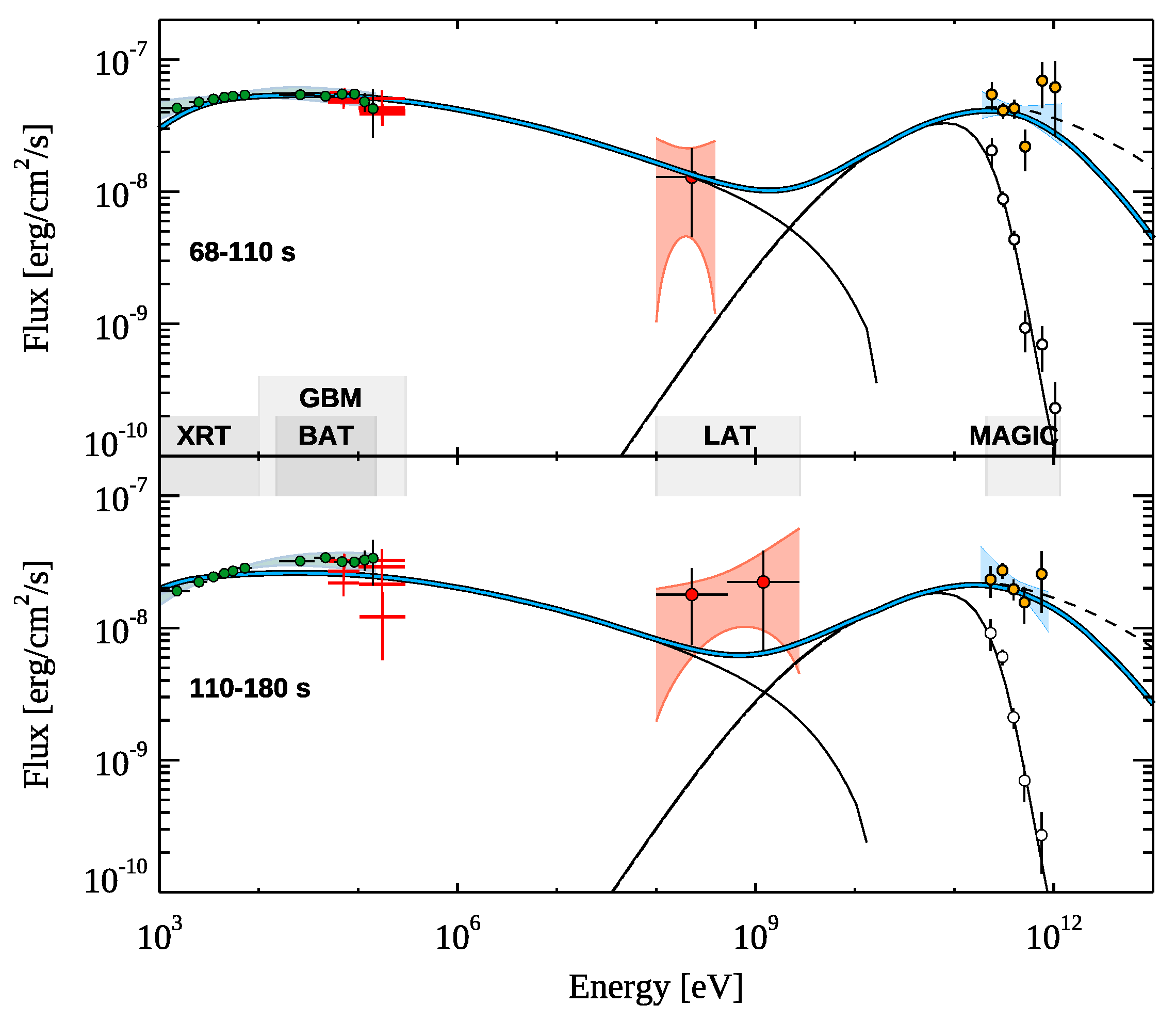
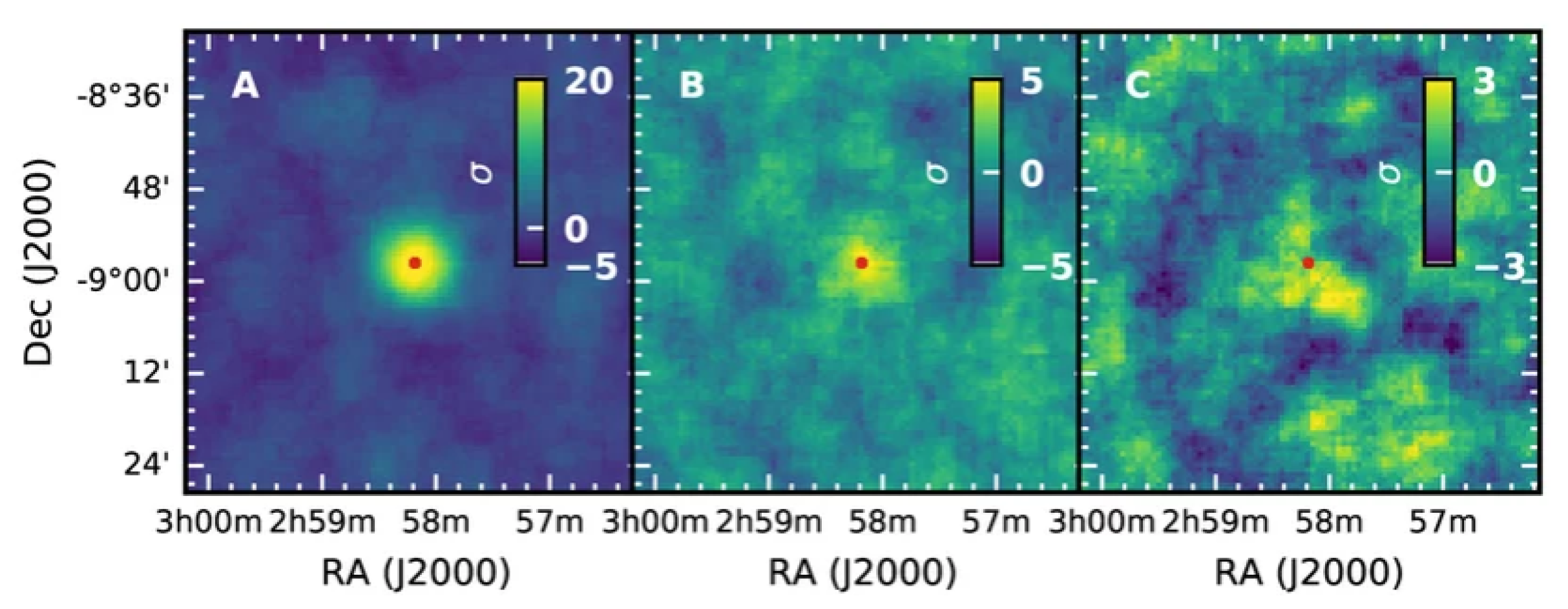
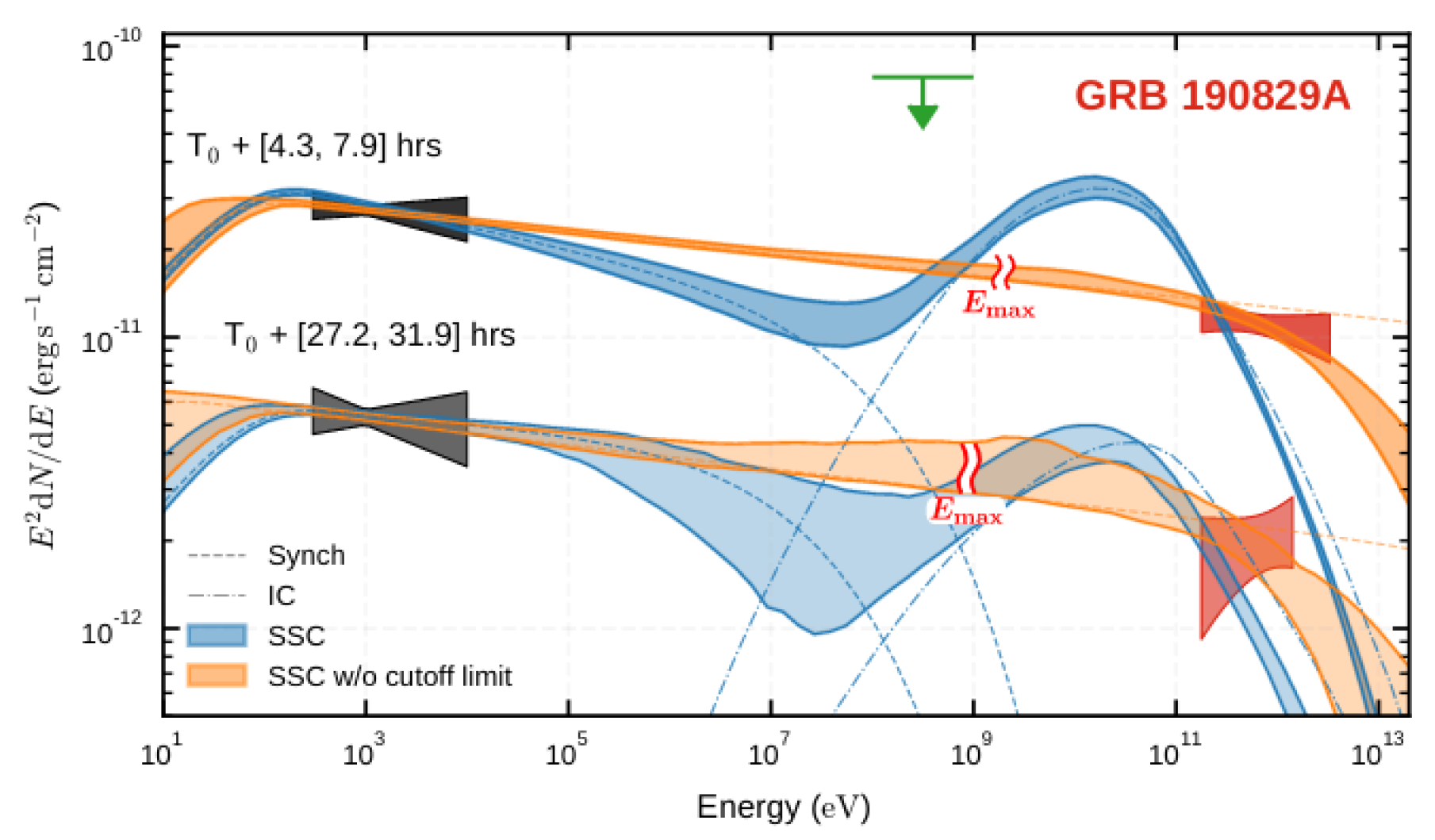
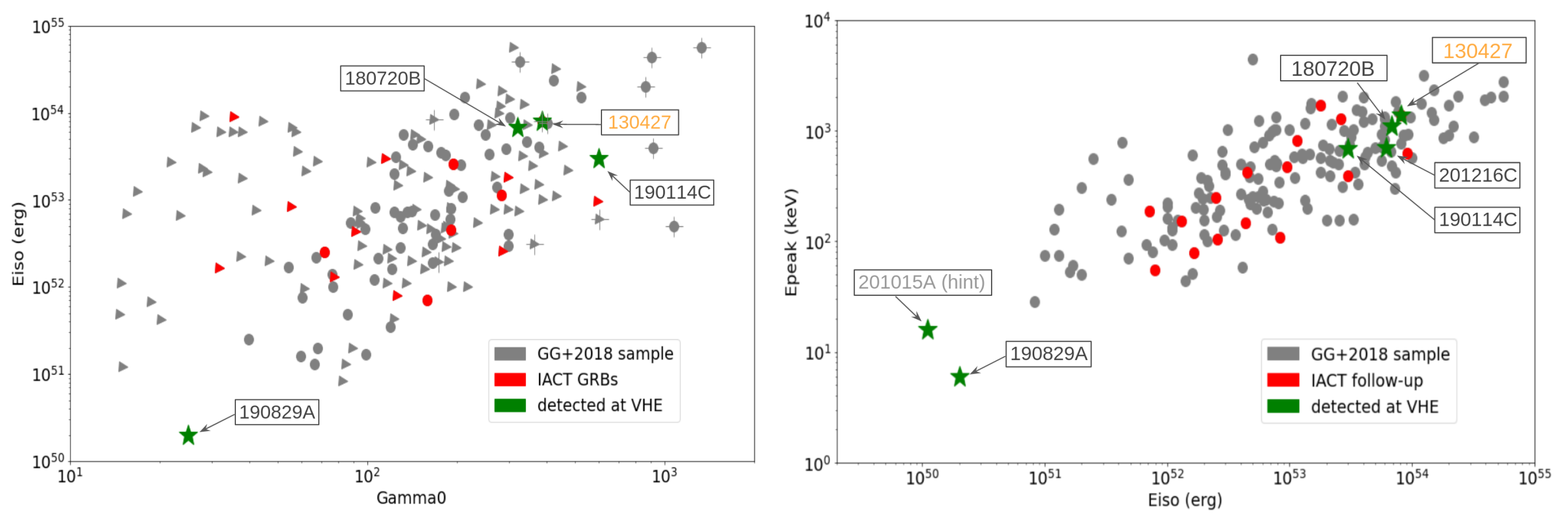
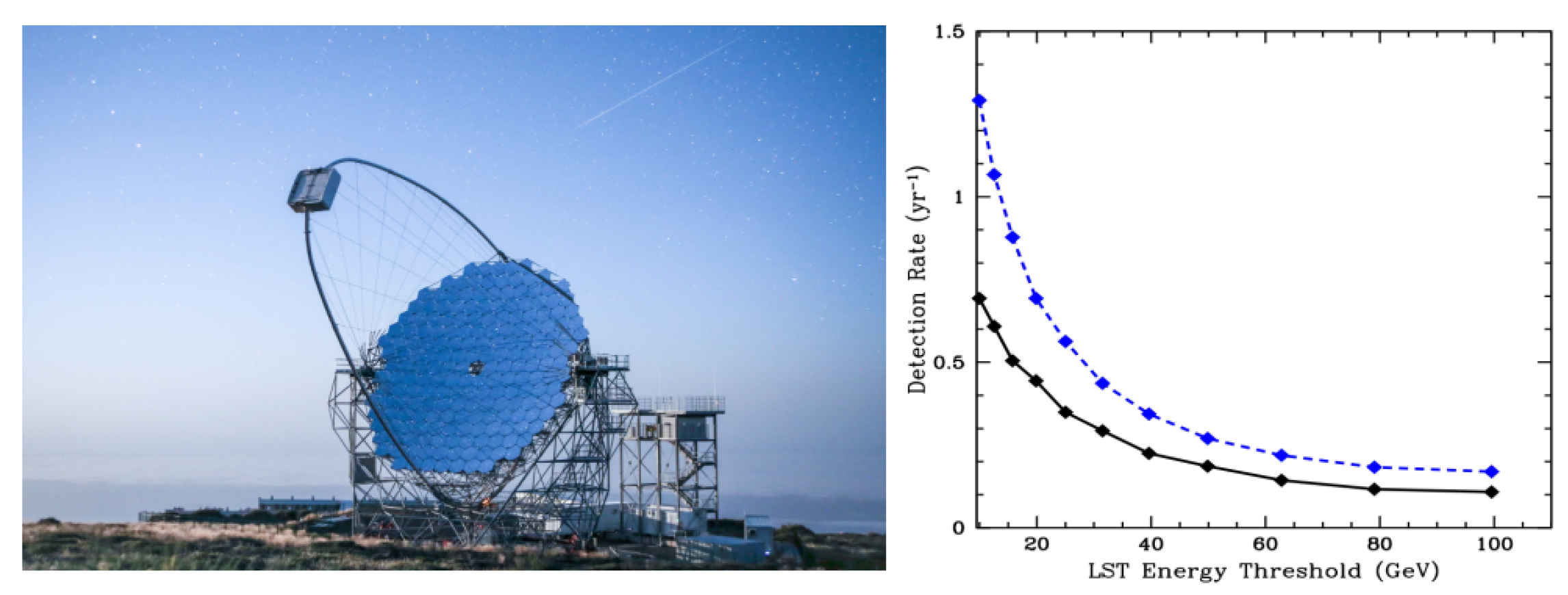
| Name | [s] | Redshift | [erg] | IACT | ||
|---|---|---|---|---|---|---|
| 180720B | 48.9 | 0.653 | 6 × 10−53 | H.E.S.S. | 440 GeV | |
| 190114C | 362 | 0.4245 | 3 × 10−53 | MAGIC | 1 TeV | |
| 190829A | 58.2 | 0.0785 | 2 × 10−50 | H.E.S.S. | TeV | |
| 201216C | 48 | 1.1 | 5 × 10−53 | MAGIC | - | - |
| 201015A | 9.8 | 0.423 | 10−50 | MAGIC | - | - |
Publisher’s Note: MDPI stays neutral with regard to jurisdictional claims in published maps and institutional affiliations. |
© 2022 by the authors. Licensee MDPI, Basel, Switzerland. This article is an open access article distributed under the terms and conditions of the Creative Commons Attribution (CC BY) license (https://creativecommons.org/licenses/by/4.0/).
Share and Cite
Berti, A.; Carosi, A. The Detection of GRBs at VHE: A Challenge Lasting for More than Two Decades, What Is Next? Galaxies 2022, 10, 67. https://doi.org/10.3390/galaxies10030067
Berti A, Carosi A. The Detection of GRBs at VHE: A Challenge Lasting for More than Two Decades, What Is Next? Galaxies. 2022; 10(3):67. https://doi.org/10.3390/galaxies10030067
Chicago/Turabian StyleBerti, Alessio, and Alessandro Carosi. 2022. "The Detection of GRBs at VHE: A Challenge Lasting for More than Two Decades, What Is Next?" Galaxies 10, no. 3: 67. https://doi.org/10.3390/galaxies10030067
APA StyleBerti, A., & Carosi, A. (2022). The Detection of GRBs at VHE: A Challenge Lasting for More than Two Decades, What Is Next? Galaxies, 10(3), 67. https://doi.org/10.3390/galaxies10030067






